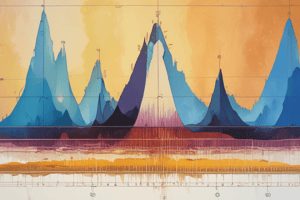Podcast
Questions and Answers
What is the primary difference between one-tailed and two-tailed tests?
What is the primary difference between one-tailed and two-tailed tests?
- Two-tailed tests can only be used when the sample size is small.
- One-tailed tests have equal statistical power as two-tailed tests.
- One-tailed tests assess relationships in both directions, while two-tailed tests assess in one.
- One-tailed tests only consider an effect in one direction, while two-tailed tests consider both directions. (correct)
In a two-tailed test, at what Z-value should the null hypothesis be rejected?
In a two-tailed test, at what Z-value should the null hypothesis be rejected?
- Z < -1.960 or Z > 1.960 (correct)
- Z > 1.645
- Z < -1.645
- Z < 0
Which scenario is most appropriate for using a one-tailed test?
Which scenario is most appropriate for using a one-tailed test?
- Evaluating if a new dietary supplement has any impact on weight gain or loss.
- Determining if a new medication is effective without considering its potential harm. (correct)
- Assessing whether two companies have similar average profits.
- Comparing the effectiveness of two different teaching methods.
What is the statistical power in the context of hypothesis testing?
What is the statistical power in the context of hypothesis testing?
Why might a researcher choose to conduct a two-tailed test instead of a one-tailed test?
Why might a researcher choose to conduct a two-tailed test instead of a one-tailed test?
What does the first quartile (Q1) represent in a dataset?
What does the first quartile (Q1) represent in a dataset?
Which of the following statements about the interquartile range (IQR) is correct?
Which of the following statements about the interquartile range (IQR) is correct?
What happens to the median in a non-normal distribution?
What happens to the median in a non-normal distribution?
What is the significance of the whiskers in a boxplot?
What is the significance of the whiskers in a boxplot?
What does the term 'outliers' refer to in data analysis?
What does the term 'outliers' refer to in data analysis?
Which quartile divides the dataset into two equal halves?
Which quartile divides the dataset into two equal halves?
When is the median and IQR preferred over the mean and standard deviation?
When is the median and IQR preferred over the mean and standard deviation?
Which of the following defines the third quartile (Q3)?
Which of the following defines the third quartile (Q3)?
How does SPSS identify outliers using Tukey's fences method?
How does SPSS identify outliers using Tukey's fences method?
What characteristic of a Q-Q plot indicates perfect normality of data?
What characteristic of a Q-Q plot indicates perfect normality of data?
What does a detrended normal Q-Q plot primarily indicate?
What does a detrended normal Q-Q plot primarily indicate?
What is indicated by a p-value greater than 0.05 in hypothesis testing?
What is indicated by a p-value greater than 0.05 in hypothesis testing?
What statistical test is sensitive to tail values when assessing normality?
What statistical test is sensitive to tail values when assessing normality?
In a stem-and-leaf plot, what does the 'stem' represent?
In a stem-and-leaf plot, what does the 'stem' represent?
What is the significance of the alpha level (α) in hypothesis testing?
What is the significance of the alpha level (α) in hypothesis testing?
How are extreme values represented in a stem-and-leaf plot?
How are extreme values represented in a stem-and-leaf plot?
What does a p-value of 0.03 signify in the context of hypothesis testing?
What does a p-value of 0.03 signify in the context of hypothesis testing?
Flashcards are hidden until you start studying
Study Notes
Data Analysis Overview
- Assignment details provided on myCourses with grading rubric.
- Student groups and topics to be announced next week.
Assessing Normality
- Empirical Rule indicates how data is distributed within quartiles.
- Quartiles divide data into four parts:
- First Quartile (Q1): 25th percentile, separates lowest 25% from the rest.
- Second Quartile (Q2): 50th percentile, the median of the data.
- Third Quartile (Q3): 75th percentile, separates highest 25% from the rest.
Boxplots and IQR
- Boxplots display data distribution visually using quartiles and whiskers.
- Interquartile Range (IQR) is calculated as Q3 - Q1, representing variability.
- Median and IQR are preferred over mean and standard deviation for non-normally distributed data.
Outlier Detection
- Outliers are extreme observations in data that can skew results.
- Tukey’s fences method categorizes outliers:
- Outliers: Values outside Q1 - (1.5IQR) and Q3 + (1.5IQR).
- Extreme outliers: Values outside Q1 - (3IQR) and Q3 + (3IQR).
Visual Assessments of Normality
- Histogram with normal curve provides a visual on the distribution.
- Quantile-Quantile (Q-Q) Plot compares data distribution to a standard:
- If normally distributed, points align with the line.
- Detrended normal Q-Q Plot shows deviation from expected values.
Stem-and-Leaf Plots
- Displays frequency of data values using 'stem' (first digits) and 'leaf' (last digits).
- Useful for examining data distribution and identifying extreme values.
Statistical Tests for Normality
- Shapiro-Wilk test checks if data is normally distributed (p > 0.05 indicates normality).
- p-value represents the likelihood that results are due to chance:
- Less than 0.05 indicates statistical significance.
Hypothesis Testing
- One-tailed tests check for relationships in one direction (µ > µ0 or µ < µ0).
- Two-tailed tests assess relationships in both directions (µ ≠ µ).
- Reject null hypothesis based on Z-value thresholds:
- One-tailed: Z < -1.645 or Z > 1.645.
- Two-tailed: Z < -1.960 or Z > 1.960.
Considerations for Testing
- Two-tailed tests are more common; one-tailed tests apply when directionality is specific.
- Scenarios for choosing one-tailed vs. two-tailed tests can vary based on research hypothesis.
Studying That Suits You
Use AI to generate personalized quizzes and flashcards to suit your learning preferences.




